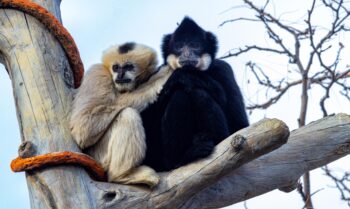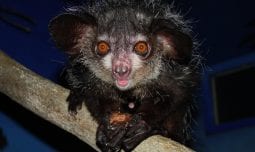December 6, 2018
What Does it Take for a Baby Aye-Aye to Survive & Thrive?
For Tonks, it took four years, the collaboration of ten departments at Denver Zoo, input from five external institutions and one FedEx plane.
By Becky Sturges, Lead Primate Keeper
In 2011, Denver Zoo was one of the few institutions to care for endangered aye-ayes in North America. We were home to a four-member family of these cute, curious and elusive creatures: mom, Salem; dad, Ozony-Avelo; and sons, Pan and Imp. The successful births of those two little males were a huge boost for the species, and set in motion a series of events that changed the captive aye-aye population across the globe.
Because aye-ayes are spread around the country in AZA accredited zoos, the Species Survival Plan (SSP) is in place to manage aye-aye mating and keep the genetics of the population healthy. As a member of the SSP program—along with other AZA accredited zoos caring for aye-ayes—we were given a recommendation in 2014 that would impact all four aye-ayes under our care. In the best interest of our aye-ayes, we jumped at the chance to help the population. It was recommended that three of our aye-ayes move to Europe to introduce new genes across the pond. As part of this plan, we also found out there would be a new breeding female to pair with our remaining male.
Ready for Take Off
Transporting an animal to another zoo is complicated enough, but moving them internationally requires even more collaboration and coordination. Over the course of a year and a half, our registrar orchestrated all the details to move our three aye-ayes to Europe. There were numerous logistics, and before Salem, Pan and Imp could leave, they each received veterinary exams to ensure that they were healthy enough to make the trip.
Because of aye-ayes’ destructive nature and ever-growing incisors, they need to constantly be chewing on things. As a solution, the Zoo’s maintenance department designed aye-aye-proof shipping crates for their big European trip. The primate team worked to familiarize the aye-ayes with these crates to reduce stress during transport. Salem, Pan and Imp had established trusting relationships with their keepers, and it was important for familiar faces to travel with them to make sure they arrived safely and acclimated to their new homes.
Settling Into New Homes
In September 2014, two of our keepers flew with the three aye-ayes to Europe. They arrived safely, and made it through customs without any complications. It was time to go to their new homes. Salem headed to the London Zoo, and Pan and Imp ventured to the Durrell Wildlife Conservation Trust in Jersey, United Kingdom. Our keepers stayed for a week at each location to ensure that Salem, Pan and Imp were happy in their new homes; eating, drinking, getting comfortable with their new keepers and enjoying their new spaces.
Once Salem, Pan and Imp were settled in Europe, it was time to bring in a new female for our male, Ozony-Avelo. The best match for him was a female named Bellatrix from the Duke Lemur Center. But this was a big transition—her first zoo and first time in a breeding situation. Bellatrix’s keeper accompanied her to Denver Zoo to help us learn about her preferences and quirks. Bellatrix had never seen a glass window, and she had never seen excited visitors, so we slowly introduced her to those new experiences to ensure she would be totally comfortable.
Sad News and Altered Plans
A few weeks before Ozony-Avelo and Bellatrix were going to be introduced to one another, Ozony became very ill. Despite the heroic effort put forth by our veterinary team to help Ozony get well again, he did not respond to the treatment and passed away a few days later. The primate team, Denver Zoo and the aye-aye community were devastated.
After receiving this sad news, the aye-aye SSP identified another aye-aye as a match for Bellatrix. He was a dapper young male named Smeagol from the Philadelphia Zoo. Again, we made all the intricate plans and arrangements to get him to the Denver Zoo. Soon, Smeagol and his new keeper boarded a FedEx plane back to his new home in Denver.
Once Smeagol arrived at Denver Zoo, we started the process of introducing him to Bellatrix. Both aye-ayes were young animals with no experience breeding. Aye-ayes are solitary animals in the wild, but meet up during times when females are able to breed and when their territories intersect. In order to make this introduction a success, we planned for a time when Bellatrix would be at the peak of her cycle and interested in mating. The introduction went well, and we had two dynamic aye-ayes in our nocturnal exhibit, giving our visitors a great opportunity to get to know these unique creatures.
Try, Try Again
Aye-ayes are not seasonal breeders, which means they can get pregnant at any time of the year. Five months after being introduced to Smeagol, we started to notice indicators that Bellatrix was pregnant. The team was ecstatic. We eagerly prepared for the arrival of a baby aye-aye. Unfortunately, nothing is ever guaranteed and when Bellatrix gave birth to her first baby, it was a stillborn. The team mourned the loss and made adjustments for the future. We reintroduced Smeagol to Bellatrix when she was ready to breed again. Bellatrix and Smeagol were successful at conceiving two more times, but had two more losses. It is not uncommon for inexperienced mothers to not be immediately successful producing and rearing offspring. After each loss, the veterinary team, reproductive specialist, and the primate team assessed what we could modify to improve Bellatrix’s chances for producing a healthy baby.
In addition to a few other minor tweaks, we began a training program that would help us monitor and assist Bellatrix. One of the primate keepers caring for the aye-ayes trained Bellatrix to voluntarily present her stomach so that ultrasound gel and a probe could be applied. This training took months of coordination and hard work, but was rewarded by the confirmation of a baby’s heartbeat. The ultrasound showed the heart beating at 88 beats per minute. This was the first time we ever had in-utero information about an aye-aye baby.
On August 8th—one week after pregnancy was confirmed—a keeper peeked in to Bellatrix’s nest and discovered that she had a live baby! The entire team was thrilled to experience this rare moment.
World, Meet Tonks
Our birth management plan included specific benchmarks we needed to see in these first few days of life. The baby was brought to a quiet place to allow the veterinary team to perform a medical assessment, and for the first time, the team saw our little female aye-aye in the light. Excitement filled the air and we were officially in love.
The baby aye-aye’s weight and temperature were on the low end of what is recommended from the aye-aye SSP, so we quickly returned the baby to the nest with Bellatrix, and set up keeper observations to monitor mom and baby’s behavior. During these observations, we saw some indications that Bellatrix was not being an attentive mother. The team’s goal was to keep them together and give Bellatrix the opportunity to become an experienced mother. Soon, however, it was obvious we’d have to intervene to keep the baby alive.
The baby made it through the night, and emerged with her name, Tonks—another Harry Potter character as homage to her mother, Bellatrix.
We had to teach Bellatrix how to feed her baby, a skill she did not understand. In order to do this, we needed Bellatrix to be sedated so that she would remain calm and allow Tonks to find milk. Tonks caught on quickly, which allowed us to leave her in the nest box with Bellatrix and to increase the time they spent together. Bellatrix was comfortable with her keepers reaching in and removing Tonks for her feedings. She even allowed us to position Tonks on her nipple while they were both awake to encourage nursing.
After two nights in the veterinary hospital, we made the decision to leave Tonks with Bellatrix overnight. We had seen great maternal behaviors from Bellatrix: spending more time in the nest box, grooming and nursing. This was a big step for our primate team and for Bellatrix and Tonks. Everything went according to plan, and only continued to improve from then on. As Bellatrix turned from a nervous, unskilled mother into a seasoned pro, our primate team slowly reduced supplemental feeding.
Tonks in the Spotlight
When we first announced her birth, Tonks became a global sensation! She was featured in local, national and international media outlets, including People, Mashable and Daily Mail. National Geographic Photographer Joel Sartore even stopped by Denver Zoo in August to photograph her for The Photo Ark. Her images and stories have reached millions and millions of people through the media and social media, including National Geographic’s Instagram channel.
All Grown Up
Since we stopped supplemental feeding, Tonks has continued to thrive! She continues to gain weight, and is figuring out how to get around her enclosure. Like many first time mothers, Bellatrix was unsure about letting Tonks take her first steps out of the nest—even trying to push Tonks back in—but Tonks refused to be contained as she began exploring her world.
A very recent accomplishment was reintroducing dad, Smeagol, to Bellatrix and Tonks. At first, Smeagol was unsure about the new squirmy addition, but the three of them have fallen into a nice routine. They spend time together while still enjoying their alone time.
From conception to birth to today, it has been a long road for both Tonks and our staff. This was a massive team effort from so many different people, departments and external institutions as we worked tirelessly to keep Tonks and Bellatrix happy and healthy. And in the end, it all paid off in a big way…with the newest member of our Denver Zoo family. It truly takes a village, doesn’t it?
Tips for Viewing Aye-Ayes
Here are four tips to help you catch a glimpse of Tonks and the rest of our aye-aye family in their nocturnal habitat in Emerald Forest on your next visit to the Zoo:
- Visit Early and Late: The best times to visit is soon after the Zoo opens around 10:30 a.m. and late in the afternoon, when Tonks tends to play and explore to burn off her last amount of energy before bedtime.
- Let Your Eyes Adjust: Spend at least five minutes letting your eyes adjust to the darkness and keep cell phone lights off.
- Look Up: Tonks is very adventurous and likes to explore the entire habitat, and tends to spend more time in the higher areas.
- Get an Up-Close Look: The best way to see Tonks and learn more about aye-aye is through our Up-Close Look: Lemurs experience.
-
 April 15, 2024
April 15, 2024Good Luck, Chuck!
Good Luck, Chuck! Beloved Bachelor Relocating as Part of Asian Elephant Species Survival Plan In a heartfelt and collaborative…
-
 April 15, 2024
April 15, 2024African Impact
African Impact Two New African Field Conservation ProgramsAim to Protect Gorillas + Grey Crowned Cranes We're honored to provide…
-
 March 1, 2024
March 1, 2024Last Place(s) on Earth
Last Place(s) on Earth New Asian Field Conservation Programs Protect Asian Elephants, Sumatran Orangutans + more Indonesia's Leuser Ecosystem…






